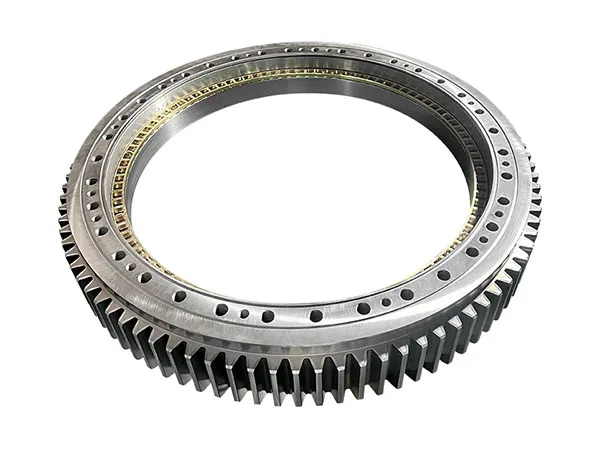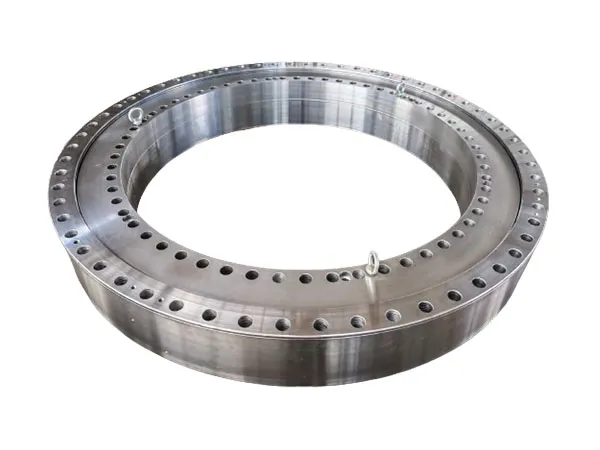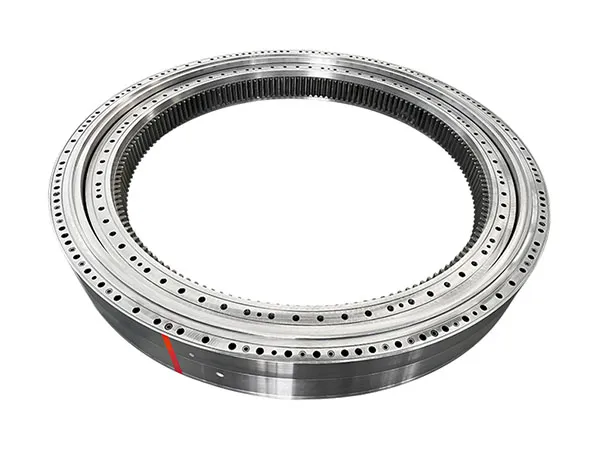- +86 13837949030 +86 15890619536
- info@lymcbearings.com export@lymcbearings.com
- Luoxin Industrial Cluster, Luoyang City,Henan Province,China
Time:2025-10-13 05:45:50 Source:LYMC Slewing Bearing
Slewing bearings are key components in heavy machinery, including excavators, cranes, wind turbines, and industrial robots. They endure massive loads in challenging environments, making proper maintenance essential for safety, reliability, and long-term performance.、
Neglecting maintenance often leads to premature failures, costly downtime, and expensive repairs. This guide provides practical steps to keep your slewing bearings running smoothly and extend their service life.

1. Core Maintenance Principle: Prevention and Regular Inspection
Slewing bearing failures rarely occur suddenly—they usually result from cumulative damage due to improper operation or lack of maintenance. Key principles include:
Preventive maintenance first: Avoid damage at the source.
Frequent inspection: Detect early signs of wear or abnormality.
Proper operation habits: Smooth operation, avoid overloading, and monitor performance.
2. Daily Operation Tips to Reduce Wear
Smooth operation: Avoid abrupt starts/stops to minimize impact loads.
Avoid overloading: Always operate within rated load capacity to prevent raceway damage and bolt failure.
Keep the platform level: For mobile equipment, operate on stable ground to avoid excessive tilting forces.
Watch for abnormal signs: Stop the machine if you detect unusual noises, sticking, or jumping.
3. Regular Lubrication: The Key to Longevity
Proper lubrication reduces friction, prevents rust, and removes debris.
Lubricant Selection:
Raceways: Use EP (extreme-pressure) lithium grease (e.g., No.2 EP Lithium) or manufacturer-recommended greases.
Ring gears:
Open gears → Open gear grease (adhesive, rain-resistant).
Enclosed gears → Gear oil matching gearbox grade.
Lubrication Schedule:
Initial: After first 100 hours for new/replaced bearings.
General: Every 500 hours or every 2 months.
Harsh conditions: Every 100–250 hours or weekly.
Lubrication Method:
Slowly rotate bearing to top position.
Use high-pressure grease gun until old grease is expelled.
Apply evenly on ring gear teeth.

4. Regular Bolt Checks
Check mounting bolts at least every 100 hours or monthly.
Always use a calibrated torque wrench and follow manufacturer’s torque specs.
Replace deformed, cracked, or corroded bolts immediately.
Maintain inspection logs for tracking.
5. Gear Mesh and Backlash Maintenance
Inspect gear teeth for wear, cracks, or pitting.
Adjust backlash per manufacturer instructions to ensure smooth, quiet operation.
Lubricate gear teeth appropriately.
6. Seal Inspection
Check seals regularly for cracks or damage.
Replace any damaged seals immediately to prevent contamination and lubricant leakage.
7. Avoid Overloading and Shock Loads
Always operate within the designed load limits.
Avoid sudden starts, stops, and uneven loading to reduce stress on the bearing.
8. Cleaning and Environmental Care
Regularly remove dust and debris around bearings.
Avoid direct high-pressure water jets on seals to prevent damage.
9. Condition Monitoring
Vibration analysis: Detect early rolling element or raceway damage.
Oil analysis: Monitor wear particles, moisture, and lubricant health.
Temperature monitoring: Identify abnormal heat buildup.
Maintain inspection logs including all observations and corrective actions.

Create an inspection log to regularly monitor the condition of the slewing bearing.
|
Inspection items |
Inspection method |
Normal phenomenon |
Abnormal phenomena and possible causes |
Treatment measures |
|
sealing strip |
Visual inspection |
In good condition, with a small amount of grease seepage |
Damaged, falling off, severe grease leakage |
Replace the sealing strip immediately and check whether the lubrication is in place |
|
Raceway clearance |
Measuring with a dial indicator |
The gap value is within the manufacturer's allowable range |
Too large a gap |
The raceway or rolling element is severely worn and needs to be closely monitored or replaced. |
|
Rotation |
Manual slow rotation |
Smooth, smooth, no stagnation |
There are stuck points, abnormal noises, and jumping sensations |
The inner raceways or rolling elements may be dented, chipped, or cracked |
|
Raceway appearance |
(During overhaul) Open and inspect |
Smooth, rust-free |
There are pits (Brinell indentation), peeling, and rust |
Poor lubrication or impact, need to evaluate whether to replace |
|
Installation Base |
Check the base |
Flat, no deformation |
There is a gap or deformation on the mounting surface |
This will cause uneven stress on the bolts and the foundation must be repaired |
|
ring gear |
Visual inspection |
The tooth shape is intact and there is oil film |
Wear, broken teeth, rust |
Check the meshing clearance and lubrication condition, if serious, repair or replace |
10. Summary: Maintenance Schedule
For ease of implementation, you can create a simple maintenance schedule:
Daily: Visually inspect seals and bolts before starting the machine, and monitor for unusual noise and vibration during operation.
Weekly/Every 100 hours: Lubricate the raceways and ring gears (under severe operating conditions).
Monthly/Every 500 hours: Perform a comprehensive lubrication and bolt torque check.
Semi-annually/Annually/Every 2000 hours: Perform a comprehensive inspection, including clearance measurement and detailed inspection of the tooth flanks and raceway condition (if applicable).
Finally, always refer to the Operation and Maintenance Manual provided by your equipment manufacturer, as different models and equipment may have specific requirements for slewing bearings.
Regular maintenance not only extends the service life of slewing bearings but also reduces downtime, maintenance costs, and operational risks. Following these guidelines ensures reliable performance and a higher return on investment for heavy equipment.